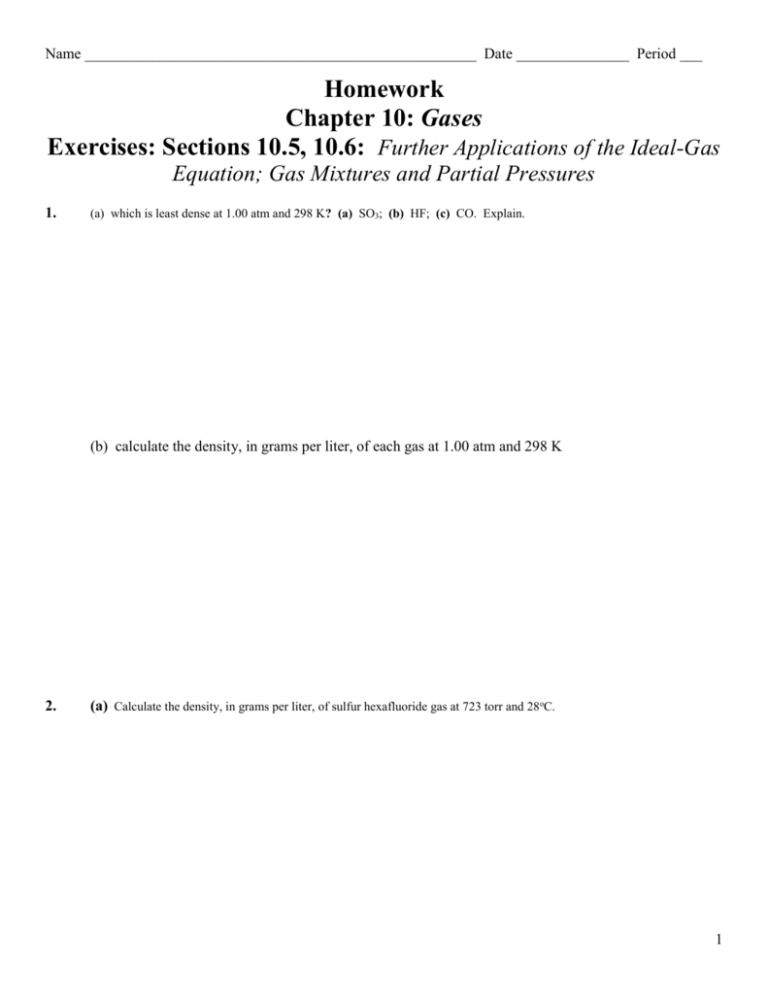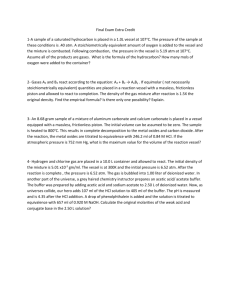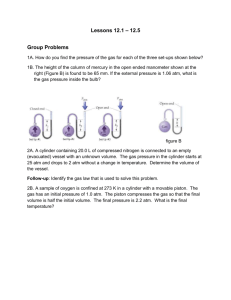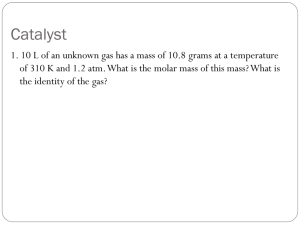+ C 2 H 2 (g)
advertisement

Name ____________________________________________________ Date _______________ Period ___ Homework Chapter 10: Gases Exercises: Sections 10.5, 10.6: Further Applications of the Ideal-Gas Equation; Gas Mixtures and Partial Pressures 1. (a) which is least dense at 1.00 atm and 298 K? (a) SO3; (b) HF; (c) CO. Explain. (b) calculate the density, in grams per liter, of each gas at 1.00 atm and 298 K 2. (a) Calculate the density, in grams per liter, of sulfur hexafluoride gas at 723 torr and 28oC. 1 2. Continued: (b) Calculate the molar mass of a vapor that has a density of 7.135 g/ L at 12 oC and 825 torr. 3. The molar mass of a volatile substance was determined by the Dumas-bulb method described in Exercise 10.51 on page 430 of the textbook. The unknown vapor has a mass of 0.846 g; the volume of the bulb was 354 cm 3, pressure 752 torr, and temperature 100oC. Calculate the molar mass of the unknown vapor. 4. Calcium hydride, CaH2, reacts with water to form hydrogen gas: CaH2(s) + 2H2O(l) → Ca(OH)2(aq) + 2H2(g) This reaction is sometimes used to inflate life rats, weather balloons, and the like, where a simple, compact means of generating H2 is desired. How many grams of CaH2 are needed to generate 10.0 L of H2 gas if the pressure of H2 is 740 torr at 23oC? 2 5. The metabolic oxidation of glucose, C6H12O6, in our bodies produces CO2, which is expelled from our lungs as a gas: C6H12O6(aq) + 6O2(g) → 6CO2(g) + 6H2O(l) Calculate the volume of dry CO2 produced at body temperature (37oC) and 0.985 atm when 4.00 g of glucose is consumed in this reaction. 6. Acetylene gas, C2H2(g), can be prepared by the reaction of calcium carbide with water: CaC2(s) + 2H2O(l) → Ca(OH)2(s) + C2H2(g) Calculate the volume, in mL, of C2H2 that is collected over water at 23oC by reaction of 0.1580 g of CaC2 if the total pressure of the gas is 726 torr? (The vapor pressure of water is tabulated in Appendix B of the textbook.) 7. Consider a mixture of two gases, A and B, confined to a closed vessel. A quantity of a third gas, C, is added to the same vessel at the same temperature. How does the addition of gas C affect the following: (a) the partial pressure of gas A; ____________________ (b) the total pressure in the vessel; ____________________ (c) the mole fraction of gas B? ____________________ 3 8. A mixture containing 2.50 g each of CH4(g), C2H4(g), and C4H10(g) is contained in a 1.50-L flask at a temperature of 15oC. (a) Calculate the partial pressure, in atmosphere, of each of the gases in the mixture. (b) Calculate the total pressure of the mixture. 9. A mixture of gases contains 5.10 g of N2, 2.83 g of H2, and 5.17 g of NH3. If the total pressure of the mixture is 2.35 atm, what is the partial pressure of each component? 4 9. Continued: 10. (a) What are the mole fractions of each component in a mixture of 5.00 g of O 2, 7.50 g of N2, and 1.00 g of H2? 5 11. A sample of 4.00 g of SO2(g) originally in a 5.00-L vessel at 18oC is transferred to a 10.0-L vessel at 25oC. A sample of 1.50 g N2(g) originally in a 2.50-L vessel at 20oC is transferred to this same 10.0-L vessel. (a) What is the partial pressure, in atmospheres, of SO2(g) in the larger container? (b) What is the partial pressure of N2(g) in this vessel? (c) What is the total pressure in the vessel? 6







